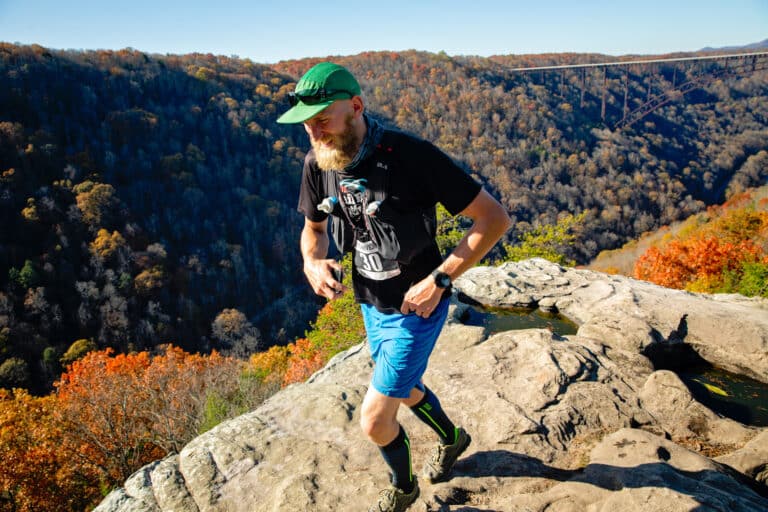After an accident left her husband disabled, a woman came to the Blue Ridge to find accessible places for them to explore the outdoors.
WHEN YOU FIRST ENTER THE huge black tunnel in the side of the mountain, you cannot see the other side, where it once again enters the light of day, about three quarters of a mile away. You can hear running water, which is a little disconcerting at first, but the crushed gravel trail looks promising. The gaping elliptical hole we enter is called the Claudius Crozet Blue Ridge Tunnel. It’s 4,273 feet in length and in the mid-1800s when it was constructed, it was the longest train tunnel in North America.
I’m about to push my husband in his manual wheelchair into its darkness. At 2.3 miles long, the Tunnel Trail is located below Rockfish Gap near Waynesboro and Afton, Va. At first this didn’t seem like the typical destination for the disabled, but we found the trailbed easy to navigate.
A few years ago, my very athletic and adventurous husband Todd suffered a devastating fall, which broke his neck and resulted in an incomplete spinal cord injury. Since then, we decided we wouldn’t be content with a life indoors, away from the beauty of nature, with its calming peace and many health benefits. So recently we traveled from our Pennsylvania home to Virginia’s stretch of the Blue Ridge to see what the area has to offer in the way of accessible trails.
We were thrilled to find multiple trails that make exploring the natural world possible for slow walkers and wheelers. Getting Todd to a trailhead isn’t always easy, but it’s worth it when I see the way being outside elevates his mood. Minor challenges like ruts or roots, or puddles of water makes things difficult, but overall, with a little energy, there are many trails we can navigate just fine.
We access the tunnel trail from the east entrance, (215 Afton Depot Lane in Afton), as it is a fairly flat .5-mile approach trail as opposed to a very steep hill on the west side. Inside, the damp coolness is comforting on a hot summer day, while the looming rock walls and the darkness help us imagine what it was like for the Irish immigrants to blast this massive tunnel. Then the welcoming light of day greets us on the other side.
We soon hear laughter echoing out of the tunnel and are surprised to encounter a jubilant group of young people, gathered around a girl with cerebral palsy in a power chair. Kaili Webster is with her church group, having a fun day outdoors. Stephanie, her mother, says the kids chose this trail because they know it is accessible and how much it means to Kaili to join in activities on fellowship outings. “It means so much to her to be a part of the group and feel no different than anyone else.”
Later, we overnight in the historic Big Meadows Lodge in the central section of Shenandoah National Park. It offers very comfortable accessible accommodations, with our room’s own private entrance. Todd’s wheelchair can get through the door, fit under the sink, and get into the shower. There is so much charm at this rustic mountaintop lodge, with far-reaching vistas from the lodge deck, and its restaurant serves delicious food, offering some Southern favorites, like fried green tomatoes, Virginia peanut soup, and hush puppies made with Virginia sweet corn, served with local hot honey. After a night of rest, we spent the rest of our trip finding more accessible trails in the area.
- Another favorite is the 1.3-mile circuit Limberlost Trail in the Shenandoah National Park. It’s a state-of-the-art accessible trail with very gentle grades and a smooth, finely crushed stone trailbed. The trail is wide enough for side-by-side walking, with benches sprinkled throughout for convenient resting, and diversity in the landscape as it winds through thick groves of mountain laurel, tall oaks, fascinating rock formations, and lacy ferns. Here we did a combo of my husband walking with his walker, then riding in his manual chair when he grew fatigued. This trail has some grades, although gentle.
- From the Luray-Hawksbill Greenway in Luray spot bucolic cows munching away inside the fence that the trail circles around. This entirely black-topped trail is a cinch to navigate across with an accessible bathroom part way round the .8-mile loop trail (Trail is a Lolli-pop configuration).
- The .8-mile Augusta Springs Wetland Trail in George Washington National Forest outside Augusta is a sweet circuit trail. It’s an aging trail that could use some repairs, but the boardwalk across the swampy marshland is particularly scenic and home to multiple waterfowl. It took us a little more effort than usual to push across some spots, as it goes from boardwalk to dirt trail, but it’s worth a visit, with white pine forest that is lovely in the summer and a great accessible bathroom.
- The .5-mile interpretive Massanutten Storybook Trail outside New Market is a fabulous paved accessible trail, leading to a spectacular view of the Shenandoah Valley and Blue Ridge Mountains but unfortunately some of the boardwalk burned in the spring 2024 Shenandoah fire and is temporarily closed, awaiting repair.
Many other accessible trails can be found by searching wheelchair and stroller-friendly trails at AllTrails.com and TrailLink.com of the Rails-to-Trails Conservancy. The National Park Service also offers a free lifetime Interagency Access pass to permanently disabled folks. You can obtain your pass at the park entrance station, or online at nps.gov/subjects/accessibility/interagency-access-pass.htm.
Cover photo by the author








